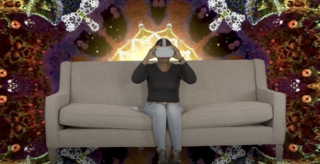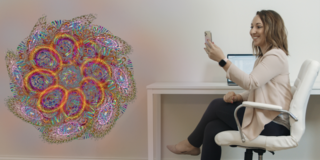Stress
A New Form of Meditation for Stress Reduction
Augmented and virtual reality can reduce stress and improve mood in minutes
Posted April 5, 2021 Reviewed by Lybi Ma
Key points
- Virtual and augmented reality meditations can reduce stress and improve mood in as little as four minutes.
- VR and AR meditations appear to be more engaging and motivating than traditional guided meditations.
- These may be good tools for people that struggle with traditional forms of meditation.
Mindfulness-based exercises, like those found in apps such as Insight Timer, Calm, and Headspace are among the most common approaches used in phone-based stress management programs (Coulon et al., 2016). This should not be a big surprise given that research has demonstrated that brief meditative experiences can significantly reduce stress and anxiety (Zeidan et al. 2010; Banks, Welhaf & Srour, 2015). More recently, it has been shown that virtual technologies, such as Augmented and Virtual Reality (AR and VR) can also be used with guided meditation experiences for quick relief of stress and anxiety.

For example, two recent studies have shown that a brief meditation-based experience using Healium VR was effective in reducing anxiety and increasing positive mood states in subjects with moderate to high levels of anxiety (Tarrant, et al., 2018) and just prior to donating blood (Tarrant, et al., 2019). What is amazing about these studies is that these changes showed up after only four minutes. The positive and efficient effects from these interventions may be partly due to the novelty of the experience as well as the immersive nature of VR/AR. In essence, virtual technologies provide a level of presence that may aid the user in becoming more engaged and motivated, potentially improving the effectiveness of the stress management technique.
Augmented reality, in comparison to virtual reality, is defined as a real-time direct or indirect view of the physical (real-world) environment that has been enhanced by adding virtual computer-generated information. Apps such as “Pokemon Go” and “Snapchat” utilize augmented reality. AR creates a novel environment that helps distract the mind from internal thoughts but does not require a complete break from physical reality. For example, you might hatch virtual butterflies from a chrysalis or brighten the sun in an AR solar system, or grow flowers in an AR garden.

While not as immersive as VR, AR apps are more user-friendly given that many can be accessed through a smartphone and do not require additional equipment. To date, there are only three known studies examining a meditation-based experience in AR. Researchers at the Shibaura Institute of Technology compared an AR stress management application to traditional teaching methods, focused on slow, methodical breathing. Their results indicated that the AR condition resulted in greater feelings of comfort and relaxation. In addition, subjects rated the more traditional experience as significantly more “boring” and resulting in tiredness (Tivatansakul & Okhura, 2014; Viczko, et al, 2021) demonstrated that a brief phone-based AR meditation (Healium AR) could significantly decrease negative mood states while significantly increasing positive mood states. In addition, a recent unpublished study (Jackson & Tarrant, 2021) has demonstrated that the Healium AR app is significantly more impactful and engaging than a phone-based distraction technique.
Taken together, these studies provide preliminary evidence that virtual and augmented meditative experiences are effective and efficient tools in decreasing stress and anxiety and improving mood states. In addition, the increased motivation and engagement observed in AR and VR applications may make this an ideal strategy for those that find it difficult to engage with audio-only guided meditation practices.
References
Banks, J. B., Welhaf, M. S., Srour, A. (2015). The protective effects of brief mindfulness meditation training. Consciousness and Cognition, 33, 277–285.
Coulon S.M., Monroe C.M., West D.S. (2016). A systematic, multi-domain review of mobile smartphone apps for evidence-based stress management. Am J Prev Med, 51(1), 95-105.
Jackson, R., & Tarrant, J. (2021). More than just a distraction: The impact of augmented reality meditation on stress, anxiety, and mood. Unpublished manuscript.
Tarrant J, Viczko J., Cope H. (2018). Virtual Reality for Anxiety Reduction Demonstrated by Quantitative EEG: A Pilot Study. Frontiers in Psychology. 9, 1280. doi: 454 10.3389/fpsyg.2018.01280
Tarrant, J., Abrams, J.S., Jackson, R. (2019). The Impact of virtual reality on mood states prior to 456 blood donation. School Journal of Psychology & Behavior Science, 2(5)-2019. SJPBS MS.ID.000150. DOI: 10.32474/SJPBS.2019.02.000150.
Tivatansakul, S., Ohkura, M. (2014). Healthcare system focusing on emotional aspect using augmented reality. Transactions of Japan Society of Kansei Engineering, 13(1), 191-201.
Viczko J, Tarrant J and Jackson R (2021) Effects on Mood and EEG States After Meditation in Augmented Reality With and Without Adjunctive Neurofeedback. Front. Virtual Real. 2:618381. doi: 10.3389/frvir.2021.618381
Zeidan, F., Gordon, N. S., Merchant, J., & Goolkasian, P. (2010). The effects of brief mindfulness meditation training on experimentally induced pain. The Journal of Pain, 11(3), 199-209


